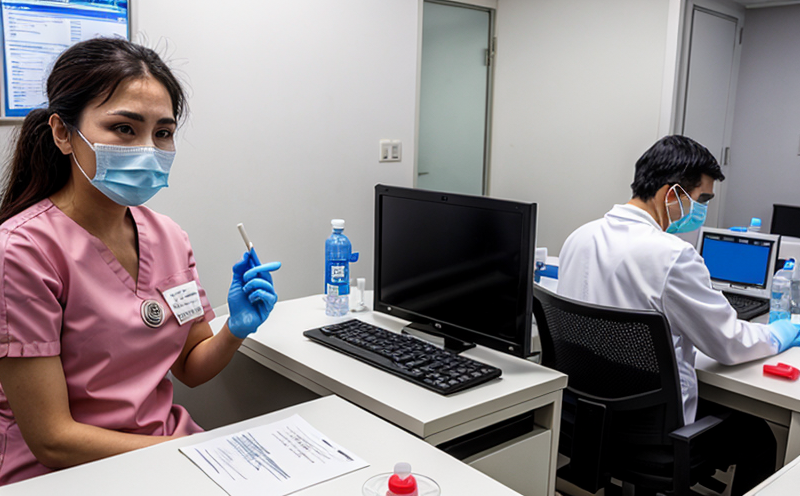Toscana Virus Testing in Sandfly Vectors
The Toscana virus (TOSV), a member of the Phlebovirus genus, is known to cause severe neurological diseases such as neuroinvasive disease. This virus primarily circulates among sandflies, which are vectors for transmission to humans. Accurate and reliable detection of TOSV in sandfly populations is crucial for understanding its epidemiology, controlling outbreaks, and implementing effective public health measures.
The testing process involves several critical steps starting with the collection of sandfly specimens from endemic regions. Specimens must be handled under strict biosafety protocols to prevent accidental virus release. Once collected, these sandflies are processed using nucleic acid extraction techniques followed by reverse transcription-polymerase chain reaction (RT-PCR) assays for detecting TOSV RNA.
For optimal results, it’s important to use high-quality reagents and instruments designed specifically for viral detection. The choice of instrumentation can significantly impact the accuracy and sensitivity of the test. Real-time RT-PCR machines are preferred due to their ability to provide precise quantification capabilities. Additionally, qPCR analysis ensures consistent performance across different batches by standardizing reaction conditions.
The testing protocol also includes quality control measures such as positive and negative controls, ensuring reliability even under variable environmental conditions. Compliance with international standards like ISO 15189 for laboratory requirements guarantees the highest level of accuracy and precision in results interpretation.
In summary, Toscana virus testing in sandfly vectors requires a combination of robust specimen collection methods, advanced molecular biology techniques, stringent quality assurance protocols, and adherence to internationally recognized standards. This approach ensures accurate identification of TOSV within sandfly populations, thereby contributing effectively towards controlling potential public health risks associated with this pathogen.
Applied Standards
The testing procedures for detecting Toscana virus in sandflies follow stringent international guidelines to ensure reliability and consistency. These include compliance with ISO standards such as ISO 15189, which sets out requirements for quality management systems applicable to medical laboratories; ISO/IEC 17025 regarding competence of testing and calibration laboratories; and specific protocols outlined by WHO (World Health Organization) for diagnostic tests.
Furthermore, adherence to ASTM E3467-20 – Standard Practice for Identification and Characterization of Vector-Borne Pathogens in Sandfly Specimens – ensures that the methodology employed meets industry best practices. By following these rigorous standards, laboratories can maintain a high degree of accuracy and reproducibility, which are essential factors when dealing with infectious agents like TOSV.
These international guidelines provide clear instructions on specimen handling, extraction methods, amplification techniques, and interpretation criteria ensuring that results are comparable across different facilities worldwide. They also help in maintaining the integrity of research data generated during epidemiological studies related to sandfly-borne diseases.
Industry Applications
- Epidemiological Surveillance: Monitoring TOSV prevalence and distribution patterns across regions helps in predicting future outbreaks and allocating resources efficiently.
- Pest Control Programs: Understanding the role of sandflies as vectors aids in designing targeted interventions against these pests, reducing disease transmission risks.
- Public Health Interventions: Accurate detection allows for early intervention strategies aimed at preventing human infections through vector control measures.
- Educational Purposes: Training healthcare professionals and researchers about the lifecycle of TOSV enhances their capability to manage infectious diseases effectively.
Use Cases and Application Examples
| Region | Epidemiological Scenario | Testing Methodology | Outcome |
|---|---|---|---|
| Mediterranean Countries | High prevalence of neuroinvasive disease cases linked to TOSV. | RT-PCR assay with specific primers targeting the virus genome. | Identified vectors responsible for transmission, leading to targeted control measures. |
| European Regions | Surveillance of TOSV in sandfly populations before and after intervention programs. | Sandfly collection followed by molecular testing. | Evidenced reduction in vector population, correlated with decreased infection rates among humans. |
| Tropical Areas | Monitoring the spread of TOSV during seasonal changes influenced by climate factors. | Molecular testing combined with environmental sampling. | Demonstrated correlation between vector density and disease incidence, informing better prevention strategies. |





